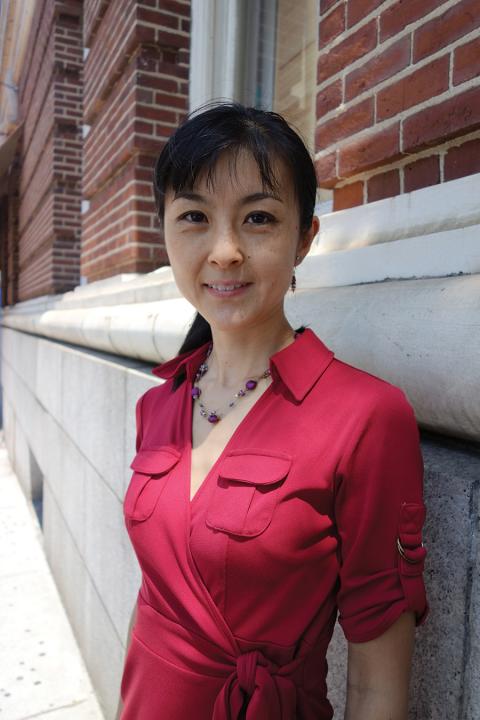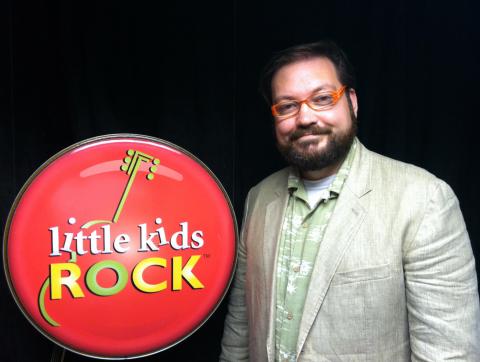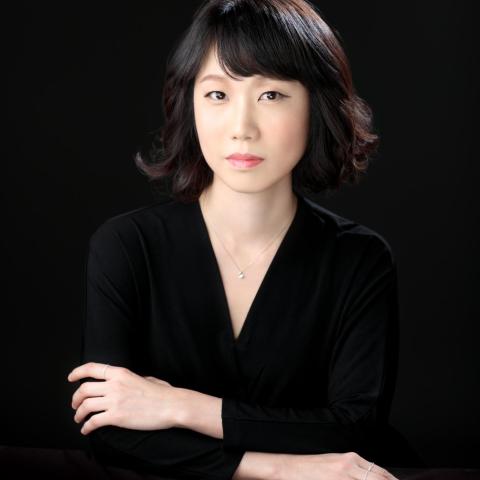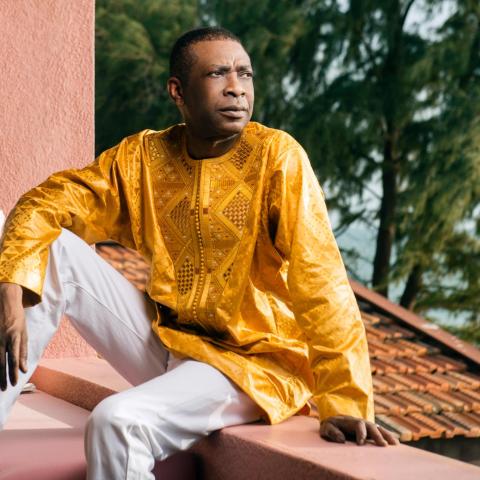Squaring the Circle
Robert Vega '06 and student musicians at Chicago's Rauner College prep school. Rauner Photo Archive
Many musicians are shaped by the music educators who guided them during formative years. A number of Berklee alumni are giving back to the next generation through a variety of educational pursuits.
Anyone who sings, plays an instrument, or creates music understands the profound power of the art form. The value of a performer’s art is appreciated universally. Many great musicians worked with an influential teacher who guided and inspired them by sharing knowledge and illuminating deeper musical realms.
Many musicians want to replicate their own experience for a new generation. The majority of professional musicians will find an opportunity to teach somewhere along their path. And a special subset of that group will discover that, for them, teaching is the performance. Introducing others to the mysteries of their art form and nurturing someone else’s talent becomes richly rewarding.
What follows are stories of music educators who have found that teaching is a calling, not a job. They are not merely showing young people how to navigate notes, these educators add richness and dimension to their student’s lives. In some cases, they offer a course correction toward a better existence.
Success Will Follow
Looking back on the 2012–2013 period, Robert Vega ’06 says he can’t believe the kind of year he had. It started out as previous years had, with Vega serving as the only music instructor for 350 inner-city kids at Rauner College Prep, a charter school in a hardscrabble Chicago neighborhood. About 95 percent of Rauner’s students come from impoverished families, and very few had ever had a music lesson. But in the fall of 2012, fortune smiled on Vega and his students.
That fall, Vega reached a few career milestones. First, he was named one of America’s five teachers of the year by People magazine. Then, while en route to New York to receive the People magazine award, Vega got a message from Patricia Steel, the program director for the Mr. Holland’s Opus Foundation. Steel (who is a 1999 Berklee graduate) called to say that Vega’s application for educational support was approved. “She told me that the foundation would provide us with $13,000 worth of new and refurbished instruments to keep our program going,” Vega says. “I don’t think I’ll ever top this. As an educator, you can’t hope for anything better than what happened for us that year.”
Good things seem to come in threes. Vega and his Rauner jazz band took fourth place in their division at Berklee’s 2013 high-school jazz festival—a competition that draws top bands from across the nation. And this third milestone was a bit of squaring the circle for Vega.
The school is in the same neighborhood where he spent his early years. At that time, there wasn’t much music education offered in the district’s schools. After his family moved to the suburbs, Vega began playing brass instruments. Following high school, he joined the United States Navy and landed an assignment at the USS Constitution in Boston. In addition to blowing “Taps” and “Reveille” at that post, Vega taught naval history to children and studied privately with Berklee Professor Greg Fritze. These experiences pointed him toward Berklee as a music education major and ultimately, a teaching career.
About five years ago, Vega moved back to Chicago and started teaching at Rauner. There was a lot of remedial work to do in large class settings. “The largest class I’ve taught had 88 students,” Vega recalls. “Last year I had classes with 60 freshmen in them, and only two or three had ever played an instrument or read music. Chicago city schools don’t offer many music programs in the elementary schools, so I’ve had to start from scratch.”
Despite the challenges, Vega has built a successful program. He’s popular with the students and has demonstrated to young and old the benefits of arts education. After receiving the People magazine award, he was deluged with requests for magazine and TV interviews and received a congratulatory call from Chicago Mayor Rahm Emanuel. The Rauner jazz band also got invitations to perform.
“The most important part of receiving this attention was that I got to speak about why I think it’s important to offer arts education in public schools,” he says. “I think that everyone will benefit from having an experience in the arts.”
Vega cites Jack Stamp, a music professor at Indiana University of Pennsylvania, who notes that music is the only discipline that simultaneously stimulates both sides of the brain. Many consider the left side to be analytical, and the right creative and emotional. Vega has noted that the majority of Rauner’s students at the top of their class are in the band.
“Stamp is fond of saying that musicians take black-and-white symbols on the page and make colors with them,” Vega says. “I want my students to be able to add color to their own worlds when they leave here.”
Vega has a ready-made bond with his students because they share commonalities. “My family was on welfare too,” he says. “But my parents were able to get off and provide a life for me and my sister. I tell these kids that there’s no reason for them to fall into generational poverty or think they can’t succeed. With a bit of hard work, success will always follow.”
Piano Instruction Reboot
Like many music professionals, pianist Gerry Diamond ’89 left Berklee determined to make his mark on the world as a performer. He wanted to establish himself as a piano-playing singer/songwriter. “After a couple years of gigging and [doing] intermittent jingle work, I found that I needed to prop up my income a bit,” Diamond says. “Teaching piano was a natural extension of my skill set.”
Gerry Diamond ’89
Diamond now operates a booming practice at Family Piano Academy in Raleigh, North Carolina. He’s assembled a staff of 17 instructors to teach some 400 students. He also employs a full-time manager to run the business so that he has time to teach as well as to develop and market his own curriculum. Diamond cites his curriculum as a key to the popularity of his academy. Once word spread through the local community that Diamond’s students were writing their own music as well as playing others’, his business blossomed.
Early on, Diamond vowed to bring the “aha” moments he experienced in his Berklee harmony, ear training, and songwriting classes to his own piano students. Sifting through available curricula, he concluded that a methodology geared toward young students had yet to be written.
“I was determined to share the basic theory knowledge I learned at Berklee,” Diamond says. “But I became frustrated with the lack of beginner and intermediate piano curricula in the marketplace that included this essential information. So I started by writing supplemental material for my students to help them to begin exploring arranging, improvising, and songwriting. By 1995 this supplemental material had grown into the first five-volume edition of my Diamond Piano Method.”
Three factors distinguish Diamond’s method from others. Because he is a songwriter rather than a classical pianist, he has geared the curriculum to connect with the pop sensibilities of his students in a way that other methods don’t. Diamond’s method also introduces students to movable-do solfêge with a continued emphasis on transposition as a launching pad to chord analysis, arranging, improvisation, and music writing. The third and most recent addition to the curriculum uses technology to enhance the connections between the students and teachers. “We launched an online practice support system last year at www.diamondpiano.com,” he says. “More than 1,000 video and audio files corresponding to the songs in the curriculum are available to our students 24/7. There are fun theory games, self-checking tests, built-in incentives, and ‘best practice’ teacher forums. It offers a real connection with their teacher that students can utilize during the six days of the week on which they don’t have a lesson.”
For the past two decades, Diamond and scores of his education colleagues have used his curriculum successfully with thousands of students. Diamond hopes that his online practice support system—which marries comprehensive methodology with the power of technology—may reboot piano-education methods for the iGeneration.
“I believe the Diamond Piano Method could become one of the go-to piano curriculums of the near future,” he says. “Its emphasis on empowering students to create original music and not to just play what’s on the page is exactly what this YouTube-oriented generation wants and deserves. Technology is now developed enough to allow musicians all over the world to communicate and share with one another, and my method is uniquely capable of bringing people into that fold. I think the time is right for a piano-instruction reboot."
Music Education with a Colombian Twist
From the left: Alejandro Cajiao ’05, Maria Morales ’01 (aka Majo), Pablo Schlesinger ’98, and Matteo de los Rios ’05. Mark Small
Established in 2007, EMMAT began humbly with a few dozen students in its first semester. But by spring 2013, 180 students were enrolled. Over the past six years, more than 1,000 students, averaging from 15 to 25 years old, have studied there. Some 20 EMMAT alumni have continued their education at Berklee and 100 have pursued further studies and professional careers in far-flung locations including America’s top music cities, plus Spain, England, Germany, Australia, Argentina, Ecuador, Brazil, and more.
The success of EMMAT is the result of a lot of hard work by Alejandro Cajiao ’05, fellow Colombian alumni, and others to create a school unlike any other in their country. “Many music schools here teach only classical or Colombian folkloric music styles,” Cajiao says. “A few music departments at the universities have a small jazz department. We’re different from the others because we start out teaching much of the Berklee core curriculum, plus courses on Colombian styles. After our students take those, they can concentrate on composition, music production, or performance.”
Founding EMMAT wasn’t Cajiao’s idea. After earning his Berklee degree in film scoring, Cajiao moved to Los Angeles to find work. When pieces weren’t readily falling into place, he pondered returning to Colombia and opening a production studio with his friend Alejandro Morales. The two Alejandros also discussed Morales’s cousin, Maria Jose Morales ’01, who had an active teaching practice in Bogotá. She dreamt of opening a music school, and the prospect intrigued Cajiao. Preparing to return home, Cajiao bought books, acoustic pianos, computer software, mixing consoles, and more in Los Angeles and sent everything to Bogotá via shipping container.
Once in Colombia, the Morales cousins and Cajiao formed a partnership and pooled their resources to develop the startup school. They found two adjacent houses suitable to retrofit as classrooms, a recording studio, ensemble rooms, and more. The Alejandros spent the next five months remodeling the facility. During that time, Cajiao also hired faculty members, including pianist and arranger Pablo Schlesinger ’98, who became a partner and later, the dean of students.
Maria Morales (aka Majo Rivera) had built a reputation in Bogotá as a jazz and pop singer and voice instructor, and when EMMAT opened its doors, her students flocked to the new school. “Without the students Maria brought here for that first semester, EMMAT would not have made it,” Cajiao says. She now teaches voice, songwriting, and ear training and is an active performer and recording artist after hours.
Cajiao’s marketing campaign through local newspapers and EMMAT’s website and Facebook page drew students. The school currently operates near capacity.
In 2008, Matteo de los Rios ’05 came onboard, bringing his expertise in music technology and Latin and folkloric music styles. He soon became EMMAT’s assistant director. “When I came in, we built the recording studio and technology center so we could teach programs such as Logic, Pro Tools, Reason, and a basic MIDI course,” de los Rios says.
He designed courses in production, recording, and mixing techniques and hired faculty members to help him teach them. De los Rios also spearheaded the effort with Colombia’s secretary of education to obtain accreditation so that EMMAT could offer a three-year music production certificate. Certification for the music curriculum is in the works currently.
EMMAT never misses an opportunity to teach—even in classrooms that bear the names of music luminaries. The school’s technology center—equipped with digital audio workstations—bears Robert Moog’s moniker. Classrooms are named after Jaco Pastorius, Duke Ellington, Olivier Messiaen, and other musical giants. “We want the students to become curious about these musicians,” Cajiao says.
“We are working toward becoming certified as a university corporation, which is comparable to a college in the U.S.,” Cajiao says. “That will require more capacity.” To that end, EMMAT purchased land, developed architectural plans, and is seeking funding to construct a three-story building. Cajiao’s hope is that a larger EMMAT will ultimately receive accreditation to grant college degrees. Cajiao and crew have also just begun offering online courses to reach musicians in other South American countries. In August, EMMAT became a member school in the Berklee International Network.
“Berklee has always been our inspiration,” Cajiao emphasizes. “We emulate its spirit of openness to all kinds of music.” “The educational philosophy at Berklee is very different than in Colombia,” de los Rios adds. “Having teachers give you the tools and tell you to use them in whatever music you wanted was new to me. I had never experienced that mentality before. We wanted to start something here with that focus.”
Genuine Mentor
Juri Ify Love
In 2001, Love was a Professional Music major, trying to decide what to do for a senior project. Then the sky exploded. “After 9/11,” she says, “I decided I didn’t want to do a recording or a recital. I wanted to do a community service project. I had seen a documentary about a guy who taught journalism to incarcerated youth in L.A., and that inspired me.”
With some guidance from Peter Spellman, the director of career development, and Berklee’s Career Development Center, Love reached out to the Dorchester District Court. The probation officer cautioned her to take a step back. “‘You’re from Japan,’” Love recalls him saying. “‘You don’t know anything about gangs. Start with at-risk youth and work from there.’”
Love took the seasoned officer’s advice and began teaching music sequencing at the Boys & Girls Club of Dorchester to six students. Two years later, the program had a roster of some 200 students and 11 teachers. Love resigned from that post to focus on her original plan of serving incarcerated youth. (After she left, the Boys & Girls Club program that she established continued to thrive. It now serves roughly 600 students.)
“This work isn’t for everybody,” Love confides. “We find that people self-select for it. We tried some recruitment, but because of the population we serve, it takes people who are very independent and confident to come and work with us.” But this doesn’t seem to have held the program back. Genuine Voices serves 10 to 15 students a week across four facilities, and has mentored more than 100 youth to date.
“Right now we have 10 teachers—almost all of whom are Berklee students and alumni, and we have interns and volunteers across the country who help with graphic design, marketing, Web development, fundraising, and grant-writing.” These back-office concerns are new challenges that Love discovered in the course of growing her nonprofit organization.
“I was able to launch the program with help from the [now discontinued] Berklee alumni grant program. But it took five years to get 501(c)(3) status, and I have realized how little I know about things like accounting, liability insurance, and how to set up a board.” Love recently completed a core certificate from Boston University School of Management’s Institute for Nonprofit Management and Leadership, and established a monthly founder’s circle where she can meet with other nonprofit leaders to discuss problems and solutions.
“It’s a lot of work,” Love says. She supports herself and the program with a dizzying schedule of private piano students, church and wedding gigs, composing, and performing gigs for the Boston Ballet. “But it’s totally worth it,” she says. Many alumni of her program have corrected their courses and rebuilt their lives.
One student developed his musical abilities to the point where he was offered a scholarship to Plugged In, a music school in Needham, Massachusetts. Another took a job in a nursing home where he also plays piano for the residents and hopes to attend medical school to become a neurologist. Love also continues her dedication to the students well after they leave the program. One alumnus recently became a father and was surprised when Love and one of her volunteers showed up on his doorstep in Connecticut with baby gifts for his new addition. Another felt her life so profoundly changed by Genuine Voices that she asked Love to play at her wedding.
The goal is to make Genuine Voices a self-sustaining nonprofit organization, and Love spends much of her time securing grants and other funding to support her work. Recent stories in the Boston Globe and other publications, coupled with the recognition she received at the recent International Association for the Study of Popular Music conference in Rome, make it clear that her work is making a difference.
For Kids About to Rock, We Salute You
Greg Pavliv ’03
Pavliv’s experience as a public-school music teacher and advocate for arts funding prepared him well for Little Kids Rock. Daunting financial odds had proven no match for his work ethic. “Before joining Little Kids, I once helped students furnish a music room from things found in a dumpster,” he admits. At another school, a twist of fate gave him brief access to Elton John’s piano. “I used it for a benefit concert, and the revenue allowed us to purchase keyboards for our school.”
His career took him to Newark, New Jersey, where Little Kids Rock had just received a grant to help develop a music program. “They were looking for teachers to implement their model,” Pavliv explains, “but few had confidence that a curriculum including rock ‘n’ roll, hip-hop and other modern styles could work in an inner-city school.” Ironically, he found this was exactly what his students needed.
“Little Kids Rock empowers students, meeting them at their level,” he notes. The program introduces songwriting and improvising early on, and helps students make CD recordings and even music videos. “I quickly implemented the curriculum for my 500 students, and took advantage of the Little Kids’ online network to bounce ideas off of other teachers.” The methods worked particularly well for Pavliv’s students, many of whom had developmental disabilities.
“Examples of success are everywhere,” Pavliv reports with contagious excitement. “We had a student with a speech impediment who was able to sing beautifully after starting our program, and she’s now teaching others. One teacher created an apparatus for a student with cerebral palsy so he could play slide guitar. Another instructor with blind students attached Braille notation to the back of a guitar to help them figure out chords.”
Pavliv’s hard work earned him a position as an ambassador recruiting other teachers for the program, eventually leading to his current position managing program directors around the country. Within three years, “We went from a staff of seven to being the largest nonprofit music education program in the U.S.. It was remarkable,” he recalls.
The Little Kids Rock story would not be as compelling without generous financial support for the organization and star power. Its 2012 gala raised $800,000, and featured guests Bruce Springsteen, Steven Van Zandt, and American Idol’s Kris Allen. “Getting their participation is a total grassroots effort,” Pavliv concedes. “Some initial connections and press coverage paid off. It spread like wildfire, and we soon had some quite famous people who wanted to be involved.” Recently, Stefan Lessard of the Dave Matthews Band spoke at a Dallas Little Kids Rock event and donated 100 acoustic guitars to the program.
Little Kids Rock is keeping its eyes fixed on the future. “We’re developing means for promising students to learn more about our pedagogy and develop a higher-education path for them to become certified teachers and Little Kids Rock instructors,” Pavliv says. “The online resources on our website and on iTunes University are also expanding. In the future, we hope to have our whole program online so teachers not directly affiliated with us can download materials for free.
“It’s not our business to solve all the problems our students face,” Pavliv says. “However, our business is to give them hope by unlocking their creative potential. I believe we’re largely succeeding there, and we’re giving them a reason to want to come to school.” As Pavliv says, “Our mission won’t be complete until the entire Little Kids Rock staff is unemployed!”




